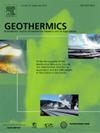Machine learning for fault-controlled geothermal systems exploration in Chenzhou and Huizhou region, Southeast China
IF 3.9
2区 工程技术
Q3 ENERGY & FUELS
引用次数: 0
Abstract
This study investigates fault-controlled geothermal systems in southeastern China, focusing on representative regions in Hunan, Guangdong, and Jiangxi provinces. A machine learning approach—non-negative matrix factorization with k-means clustering (NMFk)—was applied to classify geothermal water types and delineate favorable exploration zones based on hydrochemical composition, flow rate, heat flow, and fault proximity. Geothermal waters were classified into three types with distinct geochemical and geological attributes: Type A, Type B, and Type C. Representative geothermal fields—Nuanshui (Type A), Longmen and Reshui (Type B), and Chengkou (Type C)—were selected to validate the classification and analyze reservoir characteristics and genetic mechanisms. Type B geothermal water exhibits the highest exploration potential, characterized by deep circulation (1900–5300 m), high reservoir temperatures (66–143 °C), strong confinement, and enrichment in Na⁺ and Li⁺. Its formation is primarily controlled by NW-trending faults and high heat-producing granites. Type C geothermal water shows moderate potential, with the highest heat flow (83 mW/m²), deep circulation (3500–5400 m), and elevated temperatures (109–127 °C), despite lower flow rates. It is hosted in granitic reservoirs associated with NE–N-trending faults. In contrast, Type A demonstrates the lowest geothermal potential, featuring shallow circulation (900–2100 m), lower temperatures (42–75 °C), high flow rates, and enrichment in Mg²⁺, Ca²⁺, and Sr²⁺, reflecting strong meteoric recharge and limited geochemical evolution. A conceptual model is proposed in which meteoric water infiltrates through fault zones, absorbs heat during deep circulation within granitic or carbonate rocks, and ascends to form geothermal reservoirs or surface springs. The classification results align well with spatial patterns of geothermal favorability, offering a robust framework for geothermal resource assessment and supporting sustainable development strategies in southeastern China.
机器学习在郴州和惠州地区断控地热系统勘探中的应用
本文以湖南、广东、江西等地为研究对象,研究了中国东南部的断层控制地热系统。基于水化学成分、流速、热流和断层邻近度,采用机器学习方法-非负矩阵分解与k-均值聚类(NMFk) -对地热水类型进行分类,并圈定有利勘探带。选取具有代表性的暖水(A型)、龙门热水(B型)和城口(C型)地热田进行分类验证,分析储层特征和成因机制。B型地热水具有深部循环(1900 ~ 5300 m)、储层温度高(66 ~ 143℃)、封闭性强、Na +和Li +富集等特点,勘探潜力最大。其形成主要受北西向断裂和高产热花岗岩控制。C型地热水显示出中等潜力,尽管流量较低,但热流最高(83 mW/m²),深层循环(3500-5400 m),温度较高(109-127°C)。它赋存于与ne - n向断裂有关的花岗质储层中。A型地热潜力最低,环流浅(900 ~ 2100 m),温度较低(42 ~ 75℃),流量大,且Mg +、Ca +和Sr +富集,反映了强烈的大气补给和有限的地球化学演化。提出了一种气象水通过断裂带渗透,在花岗岩或碳酸盐岩深层循环中吸收热量,并上升形成地热储层或地表温泉的概念模型。分类结果与地热有利度的空间格局吻合较好,为地热资源评价和支持中国东南部可持续发展战略提供了强有力的框架。
本文章由计算机程序翻译,如有差异,请以英文原文为准。
求助全文
约1分钟内获得全文
求助全文
来源期刊

Geothermics
工程技术-地球科学综合
CiteScore
7.70
自引率
15.40%
发文量
237
审稿时长
4.5 months
期刊介绍:
Geothermics is an international journal devoted to the research and development of geothermal energy. The International Board of Editors of Geothermics, which comprises specialists in the various aspects of geothermal resources, exploration and development, guarantees the balanced, comprehensive view of scientific and technological developments in this promising energy field.
It promulgates the state of the art and science of geothermal energy, its exploration and exploitation through a regular exchange of information from all parts of the world. The journal publishes articles dealing with the theory, exploration techniques and all aspects of the utilization of geothermal resources. Geothermics serves as the scientific house, or exchange medium, through which the growing community of geothermal specialists can provide and receive information.
 求助内容:
求助内容: 应助结果提醒方式:
应助结果提醒方式:


